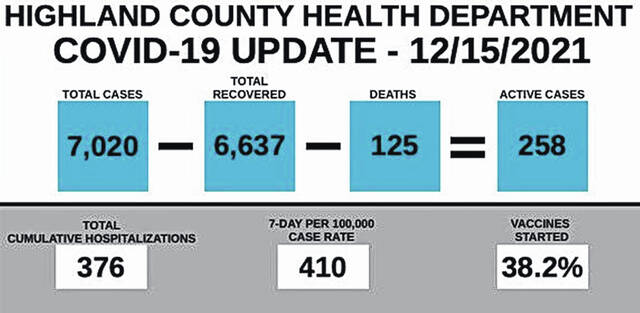
Editor’s Note — Highland County Health Commissioner posted a COVID-19 update Wednesday on the health department’s Facebook page. The post appears below in its entirety.
Case counts have increased in Highland County and in our neighboring counties since early December. We are currently seeing 410 cases per 100,000 population on a 7-day average. This means that we are seeing about 24 new cases a day. Nationally case counts are up overall as well.
Hospitalizations — State and regional hospitalizations have reached the same level as our previous Delta peak in SW Ohio. Rural hospitals are currently doing slightly better than our urban counterparts, but this is largely due to rural hospitals transferring severe cases into our larger health care centers. At some point, we can no longer transfer out as easily, and serious cases will remain in our local hospitals. With our overall case counts still consistently high, we are likely to continue seeing hospital capacity issues.
COVID-19 Test Positivity Rates – A quick note on using positivity rates as a predictor of current disease activity in Ohio. Early on during the pandemic, test positivity trends were a useful tool in measuring disease activity in the county. This was during the first year of COVID response when testing was only available through health care providers. Positivity rates no longer have much value in helping us understand our disease trends. Increased private workplace mandated testing for unvaccinated staff, required testing for travel, and the prevalence of home test kits are all contributing to a large number of healthy people seeking testing, and a large number of people not reporting their test results at all. Our reporting systems do not have a way to differentiate testing data based on whether someone was getting tested because they are sick, or getting tested for other reasons. I just don’t think there is much value in tracking this number anymore unless we start tracking positivity rates specifically for symptomatic people.
Omicron in Ohio – Omicron has been found in 35 states now, including Ohio, but it is likely that it is in already every state. We are starting to build a picture of omicron, but there is a lot that we still need more information on. There are also a couple of really key questions that the public health system needs to have answers to.
Will omicron outcompete delta? — In other words, with our currently high rates of delta variant COVID-19 in our area, we don’t know yet if omicron is going to outpace and replace delta as the dominant strain of disease. Initial studies from the UK and from South Africa indicate that omicron is more infectious and more likely to cause reinfection of people who have previously recovered or who are vaccinated. Will omicron crowd out delta infections? Or, as some epidemiologists and virologists predict, will we see two variant strains circulating at the same time similar to what we see with influenza?
There are some initial reports that indicate that omicron may cause less severe symptoms. We still need more data to say this conclusively, but this development could be a big step towards moving from a pandemic to an endemic disease.
I have talked previously about how the hospitalization rates are the most important number to watch on our COVID trends. Our hospitals in SW Ohio are currently seeing higher patient counts than we did in our delta surge in September. Currently we still have the ability to transfer high risk Highland County patients to larger urban hospitals, but that may change soon as our urban health care systems fill up.
What happens to our currently strained hospitals if a milder but more infectious variant comes into Highland County? A South African report released on Tuesday this week provides an early glimpse. According to this study, hospitalization is much lower for omicron than delta, and hospitalizations require shorter stays. BUT, if we see an huge increase in new cases, even a very low rate of hospitalizations has the potential to overwhelm our already full health care system. https://cdn.substack.com/…/https%3A%2F%2Fbucketeer…
Omicron does seem to reduce vaccine effectiveness (and presumably immune response due to natural infection) more easily than delta, but there is strong early evidence that vaccination still protects against severe disease, hospitalization and death. People who recently received a booster dose saw a 70-75% level of protection from infection. (https://assets.publishing.service.gov.uk/…/Technical…)
Now is the time, especially for those who are high risk, to think about a booster dose of vaccine.
We should know much more about omicron soon.
And finally, as health commissioner, I hereby make the following holiday proclamations (luckily, no one will proof read this before I post it.)
“Die Hard”, “Edward Scissorhands” and “Gremlins” are all considered Christmas movies and acceptable options for movie night. Raw cookie dough is gross, stop pretending it is some sort of holiday treat. Christmas trees can go up the day after Thanksgiving and should be down by New Year’s Eve. “Elf on the Shelf” is creepy. Feliz Navidad is the worst Christmas song in the world, followed closely by every other Christmas song ever written.
This is probably my last update of the year, so Happy Christmas everyone.


